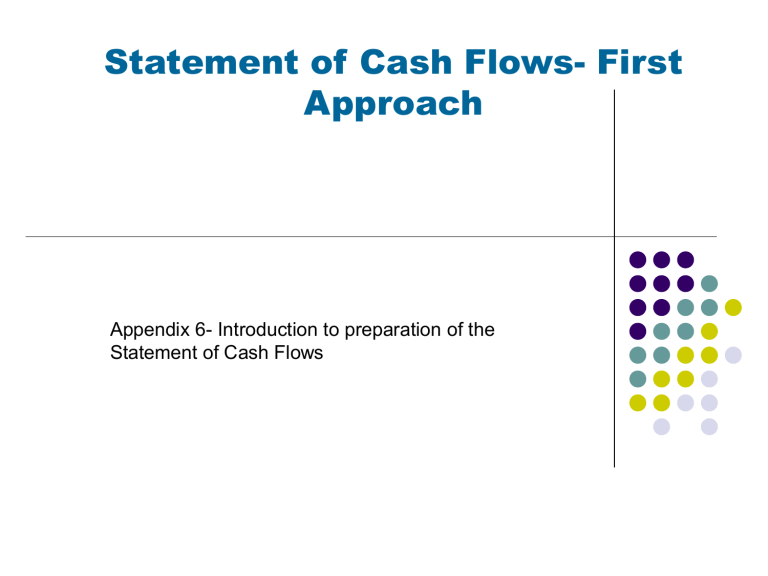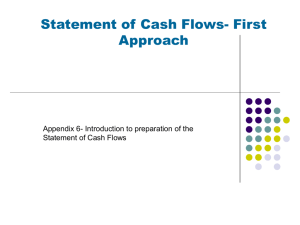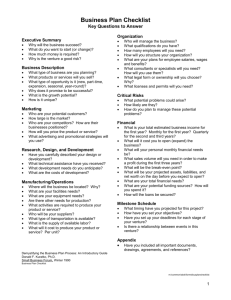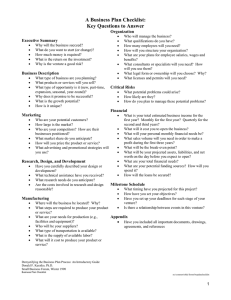
Statement of Cash Flows- First Approach Appendix 6- Introduction to preparation of the Statement of Cash Flows Cash Flow Statement Flow statement Periodic Provides information regarding the liquidity of a firm explains the reasons for increase or decrease in cash balance from one balance sheet date to the next classifies the reasons for the change as an operating, investing or financing activity. amount of net income in a period is usually different than the amount of increase in cash in the same period reconciles net income with cash flow from operations. Classification of Cash Flows Operations -- cash flows related to selling goods and services; that is, the principle business of the firm. Investing -- cash flows related to the acquisition or sale of noncurrent assets. Financing -- long term and short term cash flows related to liabilities and owners’ equity; dividends are a financing cash outflow. What is Cash? Cash includes cash and cash equivalents Cash equivalents: treasury bills maturing in 90 days or less; investment funds; foreign currency on hand; checking account and free savings account External Uses of CFS To assess the ability of a firm to manage cash flows To assess the ability of a firm to generate cash through its operations To assess the company’s ability to meet its obligations and its dividend policy To provide information about the effectiveness of the firm to convert its revenues to cash To provide information to estimate or anticipate the company’s need for additional financing Internal Uses of CFS Along side with cash budget CFS is used: To assess liquidity To determine dividend policy Determine if short-term financing is necessary Decide to distribute; or increase or decrease To evaluate the investment and financing decisions Cash flow from operating activities Examples (IAS No.7): cash received from customers through sale of goods or services performed; cash received from non-operating activities such as dividends from investments, interest revenue, commissions, and fees; cash payments to suppliers or employees; cash payments for taxes and other expenses; In effect, the income statement is changed from accrual basis to cash basis Investing Activities Examples of investing activities include: cash payments to acquire property, plant, and equipment (PPE), other tangible or intangible assets, and other long-term assets; and sale of such assets loans extended to other companies; and collection of such loans; Financing Activities Examples of financing activities are : cash received from issuing share capital; cash proceeds from issuing bonds, loans, notes, mortgages and other short or long-term borrowings; cash repayment of loans and other borrowings; and cash payments to shareholders as dividends. Classification of Cash in-flows and outflows From sales of goods and services to customers From receipt of customer advances From receipt of interest revenue or dividends or rent revenue or similar revenue items Operating Activities To wages salary payments To suppliers for purchases of inventories To other operating expenses To interest payments To tax payments To advance payments to suppliers From sale of PPE and other long-term assets Investing Activities From collection of loans From sale of common or preferred stock From issuance of short or long term debt To purchase PPE and other long-term assets To make loans and to collect such loans Financing Activities To repay debt To pay dividends Format of the Cash Flow Statement Name of the Company Cash Flow Statement For the period … Cash from operating activities A Cash from investing activities B Cash from financing activities C Net Change in Cash D = (A+B+C) increase or (decrease) + Beginning Cash balance CB, from the beginning balance sheet Ending Cash balance =CB + D should equal to ending cash balance in the ending balance sheet Non-cash Investing and Financing Activities Determination of Cash Flows From Operating Activities Direct Method Income Statement items are converted to cash flows individually Indirect Method Net income or loss is adjusted for accruals such as accounts receivable and payable, and for non-cash expenses such as depreciation reconciliation of the accrual based and cash based accounting Comparison of Methods Direct method of presentation calculates cash flow from operations by subtracting cash disbursements to supplies, employees, and others from cash receipts from customers. The indirect method calculates cash flow from operations by adjusting net income for non-cash revenues and expenses. Most firms present their cash flows using the indirect method. Only operating activities section is different between the methods, investing and financing sections are the same. How to prepare cash flow statement Firms could prepare their own cash flow statement directly from the cash account. however, we need two consecutive balance sheets and the income statement that covers the period between the two balance sheets Algebraic Formulation* Assets = Liabilities + Shareholders’ Equity or A = L + SHE Assets are either cash (C) or not (Non-Cash) Thus reorganizing C + Non Cash Assets (NCA) = L + SE C + NCA = L + SE Where means the change in the balance of the item from the previous period. Solving for change in cash: C = L + SE - NCA Based on Stickney and Weil, 10th ed. Financial Accounting Slides http://www.swlearning.com/accounting/stickney/tenth_edition/stickney.html Algebraic Formulation (Cont.) C = L + SE - NCA The change in cash, C, is the increase or decrease in the cash account. This amount must equal changes in liabilities plus changes in shareholders’ equity minus changes in assets other than cash. Thus, we can identify the causes in the change in the cash account by studying the changes in non-cash accounts. Indirect Method – cash flow from operations Adjusting Net Income of the period (accrual) to cash basis income INCREASE Assets DECREASE Increase in non-cash Decrease in non-cash assets shows that cash assets shows that was spent, they provided cash so cash outflow. so cash inflow. Increase in liabilities Liabilities cash savings; and increase in SHE cash Shareholders’ received; equity so cash inflow Decrease in liabilities or SHE shows cash paid; so cash outflow Indirect Method- operating activitiesAdjustments to net income Net income + noncash expenses: depreciation, amortization, uncollectible account expense,etc + loss on sale of asset + increases in current liabilities + decreases in current assets - gain on sale of asset - decrease in current liabilities - increase in current assets = Cashflow from operating activities Noncash Expenses Noncash expenses, such as depreciation expense, are added back – because they were deducted to measure net income but did not require any cash payment in the current period They are not truly sources of cash, even though they are associated with cash inflows but reversal of an accrued expense Portakal Company Prepare Cash Flow Statement Accounts with Debit Balances Cash Notes Receivable (from loans to other companies) Accounts Receivable Merchandise Inventory Prepaid Operating Expenses Interest Receivable Land Property,Plant and Equipment-PPE-net Accounts with Credit Balances Accounts Payable Accrued Wages Payable Income Taxes Payable Unearned Revenues Bank Notes Payable - long term Common Stock; TL 15 par value Additional Paid in Capital Retained Earnings 2008 2007 37.500 69.000 53.700 158.000 2.100 1.400 110.000 377.000 808.700 39.250 50.000 39.900 120.000 1.800 600 65.000 380.000 696.550 45.000 3.000 6.000 2.500 215.000 405.000 70.000 62.200 808.700 38.000 2.400 4.500 1.250 200.000 375.000 50.000 25.400 696.550 increase (decrease) (1.750) 19.000 13.800 38.000 300 800 45.000 (3.000) 112.150 7.000 600 1.500 1.250 15.000 30.000 20.000 36.800 112.150 Portakal Company Income Statement Sales Revenue Cost of Goods Sold Depreciation Expense Salary and Wages Expense Administrative Expenses Loss on Sale of Equipment Other Operating Expenses Interest Revenue Interest Expense Income Tax Expense Net Income 0 2008 750.000 (375.000) (43.000) (125.000) (80.000) (4.000) (5.000) 4.000 (20.000) (28.000) 74.000 The company paid TL 50.000 of Bank Notes and borrowed new bank loan. The company declared and paid cash dividends. The company sold equipment with a cost of TL 12000 and accumulated depreciation of TL 6000 for TL 2000 receving a note in return to be collected in 2009. The company purchased equipment for TL 46.000; paid TL 44.000 in 2008 and gave a note for Jan. 2009. The company issued common stock during the year . Portakal Company Cash Flow Statement Cashflow from Operating Activities Net Income Add back noncash: Depreciation Expense Loss on Sale of Equipment 2008 74000 43.000 4.000 121.000 adjustments that increase cash: increase in Acct.Payable Increase in Acc.Wages Payable increase in Income Taxes payable increase in unearned revenued adjustments that decrease cash: increase in Accts Rec. increase in Merch. Inv. Increase in Prepaid Expense increase in interest recev. Cashflow from operations 7.000 600 1.500 1.250 10.350 (13.800) (38.000) (300) (800) (52.900) 78.450 Cashflow from investing Sale of PPE (note will be received in 2009) Purchase of PPE (44.000) Loans extended( to other companies) (19.000) Purchase of land (45.000) Cashflow from investing (108.000) Cashflow from financing Bank Notes Payable - long term 65.000 Common Stock; TL 15 par value 30.000 Additional Paid in Capital 20.000 Payment of Bank loan (50.000) Payment of Dividends (37.200) Cashflow from financing 27.800 Net Change in Cash (1.750) Effects of a Sale of a Long-Term Assets on Cash Flows A few transactions complicate the derivation of a cash flow statement from a comparative balance sheet, for example, the sale of a long-term (or fixed) asset. Recall the journal entry for the sale of an asset: Cash Accumulated Depreciation Asset Gain (or loss) on sale nnnn nnnn nnnn nnnn Sale of an Asset Each of the four parts of the above journal entry require an adjustment in the cash flow statement. The first line, cash, adds a line to the investing section. The second line, a debit to accumulated depreciation, increases the depreciation expense above the change in the change in the accumulated depreciation account. The third line, a credit to the asset, increases the amount of cash invested in long-lived assets above the change in the fixed asset accounts. The fourth line, a gain or loss, is reversed out in the operating sections since this is not a cash flow. Comparison of Cash Flow to Net Income Net income is an accrual based concept and purports to show the long-term. Cash flows purport to show the short term. Consider the outlook for both short-term and long-term and consider that each is either good or poor. A strong growing firm would show both good long-term and good short-term outlooks. A failing firm would show both poor long-term and poor short term outlooks. What about a firm with good cash flows (short-term) but poor net income (long-term)? What about a firm with poor cash flows (short-term) but good net income (long-term)?




